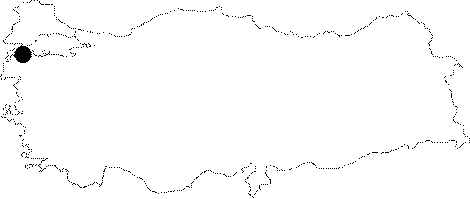|
©The Archaeological Settlements of Turkey - TAY Project
|
|
|
|
|
|
Parion |
|
|
For site maps and drawings please click on the picture...  |
For photographs please click on the photo...  |
|
Type:
|
City |
|
Altitude:
|
m |
|
Region:
|
Marmara |
|
Province:
|
Çanakkale |
|
District:
|
Biga |
|
Village:
|
Kemer |
|
Investigation Method:
|
Excavation |
|
Period:
|
Archaic |
|
|
|
 |
|
| Location: It was founded on the rugged terrain of the Bodrum Promontory, which projects into the sea to the northeast of the Kemer Village of the Balikçesme Subdistrict in the Biga District. Parion is accessed through a 14 km road that intersects from Biga-Lapseki motorway's 15th kilometer. |
| Geography and Environment: |
| History: |
| Research and Excavation: It was discovered by P. Hunt after recovery of coins in the region in 1801. Some prehistoric surveys were conducted by I.K. Kökten at Parion and its environs in 1949. Furthermore, surveys were conducted in 1970s by I. Aksit of the Çanakkale Museum, and in 1991 and 1996 by the students of the Classical Archaeology Department at Atatürk University, and in 1997 by C. Basaran from Erzurum Atatürk University [Basaran (C) 1999:350]. The campaign initiated in 2005 is conducted by C. Basaran [Basaran-Tavukçu 2007:609]. |
| Stratigraphy: The work performed at Parion resulted with the finding that the south and northeast of the city was used as necropolis [Basaran-Tavukçu 2007:610]. |
| Small Finds: Architecture: Fortifications bearing the characteristics of the 4t century BC were uncovered. Also, the acropolis, theatre, temple and necropolis area of the city were identified [Basaran (C) 1999:349-355]. Necropolis: As a result of 2005 campaign it was found out that the land was used for a long period of time. The graves unearthed at excavations were classified as; M for the ones which have or are the sub-types, but show no qualities; TM for group burials; PM for pithoi graves; TSM for sarcophagi and UM for urnes [Basaran-Tavukçu 2007:611]. A sarcophagus with carinated lid was exposed in the southwest of the trench in south necropolis in 2010. A male skeleton lying on his back towards north with his hands stretched-out was found inside the sarcophagus. Also, with a partly damaged body, a black figure lekythos which bears farewell scene of a warrior and dated to 520-510 BC was found. On the left hand of the skeleton, a strigilis and one small bronze pin were recovered. The sarcophagus and the data obtained from it show that the sarcophagi with inhumation burials were used in Parion South Necropolis at the end of 6th century. Another important discovery is; the textile pieces on the burials and the small pins found on the shoulders of the skeletons which have the remains of the same textile indicate that the burials were wrapped in textiles [Basaran et al. (H. Kasapoglu) 2012:20-23]. As a result of the studies carried out in the Southern necropolis in 2012, 14 graves were discovered. The majority of these graves are in the form of simple earth grave. Only one of seven earth graves contain a lekythos and a baked clay spindle whorl. In the sarcophagus no. L4, which was home to a female child, a marble alabastron, two metal objects with hanger and a bronze ring were found. All the graves are dated to the Archaic Period and pre-archaic period [Basaran et al. (H. Kasapoglu) 2014:399]. |
| Remains: |
| Interpretation and Dating: It is a colonial city co-founded by Paros, Erythrai and Miletus in 709 [Graham 1982:119]. In the 7th century BC, Erythrai fights against Chios and Miletus. Briefly before this battle, Erythrai founded Parion at Propontis together with Miletus [Bean 2001:134]. It is also suggested that the city may have been founded by Erythrai alone [Gorman 2001:245]. 2005 campaign proved that there are many different types of burials at the necropolis. 1) Tomb with monumental staircase [found at museum excavation], 2) Sarcophagus [found at museum excavation], 3) Grave room masonry with brick paved floor [found at museum excavation], 4) Stone sarcophagus, 5) Grave room with gable roof, 5.1) Grave with gambrel (flattened saddleback) roof, 5.1.1) Grave with gambrel (flattened saddleback) roof, with closure at one end, 5.2) Convex gable roof grave, 6) Grave with flat bottom terra cotta plate paved floor, 7) Basic burial, 8) Grave with pithos covered over head part, 9) Collective grave, 10) Urna burial, Pithos grave, 12) Wooden coffin grave. Based on these results this area was used between the second half of 4th century BC and early 2nd century AD [Başaran-Tavukçu 2007:620-622]. |